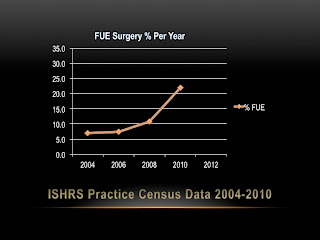In spite of the sluggish global economy, demand for hair restoration surgery is on the rise - increasing 15 percent in the U.S. and 66 percent worldwide between 2004 and 2010, according to the International Society of Hair Restoration Surgery’s 2011 Practice Census. The key reason for this spike is the demand for a less-invasive hair transplant procedure known as Follicular-Unit Extraction, or FUE.
FUE has proven to be a major advancement for the field of hair loss as it allows the surgeon to restore living and growing hair to balding patients without the traditional removal of a large strip of ‘donor’ skin from the back of the head. This traditional strip-harvest method requires the use of scalpel and stitches – and results in a tell-tale linear scar at the donor site. It’s easy to see why patients would prefer the less-invasive no-scalpel/no-stitch FUE over the traditional strip-harvest method. Now that FUE is gaining increased acceptance in the hair transplant community, and there is a growing track record of results worldwide, patient demand is soaring.
The percentage of FUE transplants doubled from 2009 to 2011. In 2009, FUE accounted for 10.8 percent of all surgical procedures; by 2011, that number had increased to 22 percent. In other words, in 2009, 25,200 of surgical hair restoration procedures were FUE transplants. In 2011, the number had more than doubled to 61,464.
For more on the increase in FUE hair transplants and key findings of the 2011 Practice Census, read my full release.


No comments:
Post a Comment